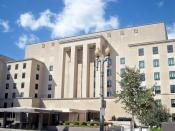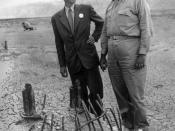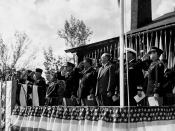On July sixteenth 1945 a cloud of smoke rose up above the desert in New
Mexico. It was less than a month later when that same cloud of smoke rose up above the
murdered bodies of at least 78,000 Japanese in the city of Hiroshima. Three days later at
least 38,000 more were killed in the city of Nagasaki by the same deadly bomb and again
the same ominous cloud of mushroom-like smoke arose. The dropping of these ruinous
bombs led to the almost unconditional surrender of the Japanese. The question that
plagued the world was, "did we have to drop the bombs?". Was Truman right in his
decision to drop a weapon with inconceivable power on two cities inhabited mostly by
civilians?
In 1938 the United States got word that the Germans were producing the
technology for an atomic bomb. We then started our own research project on nuclear
weapons, its code name was "The Manhattan District (project)."
The Manhattan District
received heavy government funding after the attack on Pearl Harbor. Most of the top
scientists in America worked on this project to develop the first atomic bomb. Major
General Leslie Groves directed the Manhattan Project. J. Robert Oppenheimer, a
physicist, headed the making and testing of the bomb in New Mexico. It was when the
bomb was tested on July sixteenth 1945, that the United States of America realized the
great power they had in hand.
Many of the scientists who worked on or knew about the Manhattan
Project did not approve the use of the weapon without a demonstration or warning the
enemy about its power. Dr. Leo Szilard, who once advised Roosevelt on the possibility of
an atomic bomb, now advised Roosevelt against dropping the bomb. Szilard wanted
Roosevelt to use an alternative method, or at...



Great
this was really helpful 2 me thanks for the info
1 out of 1 people found this comment useful.